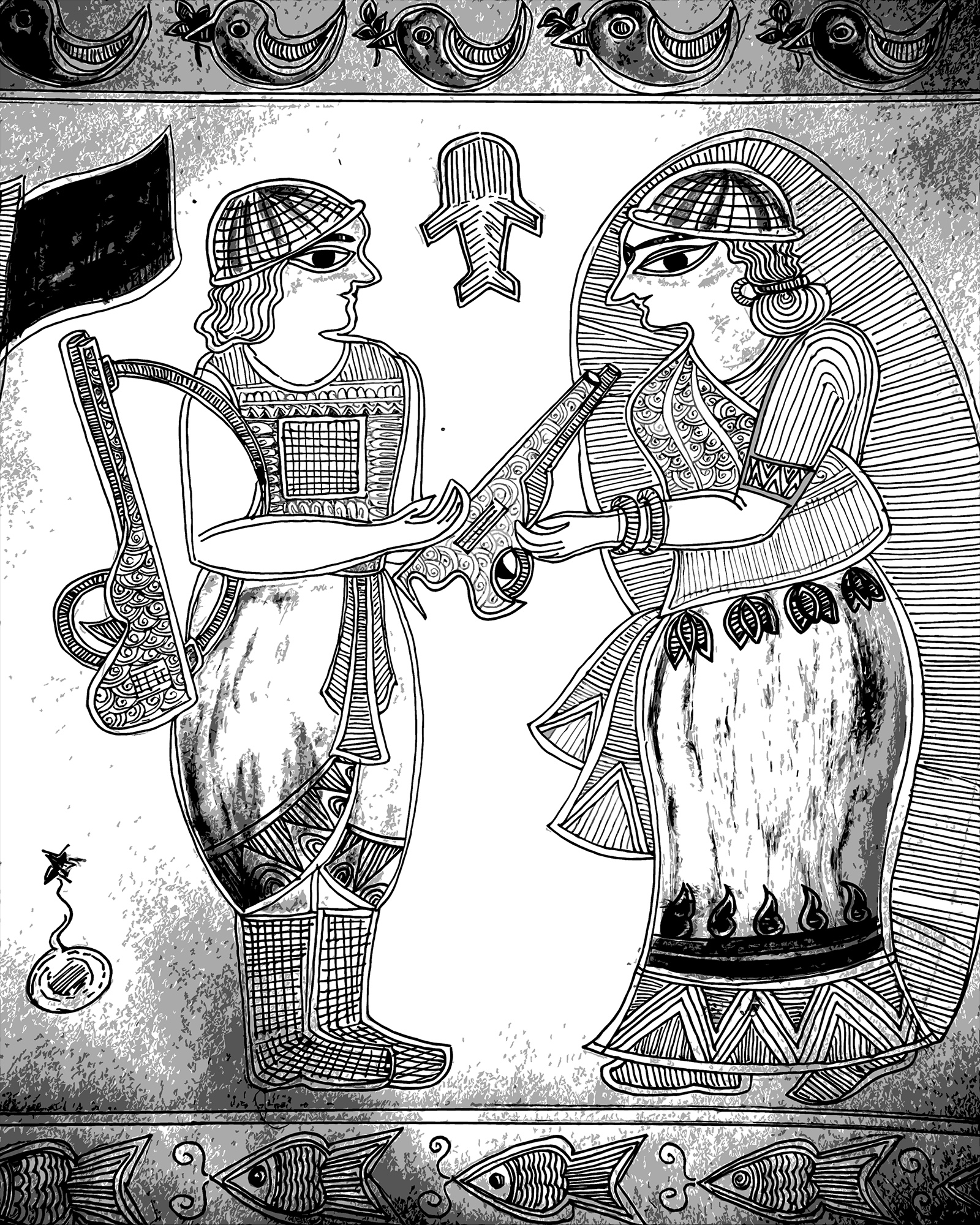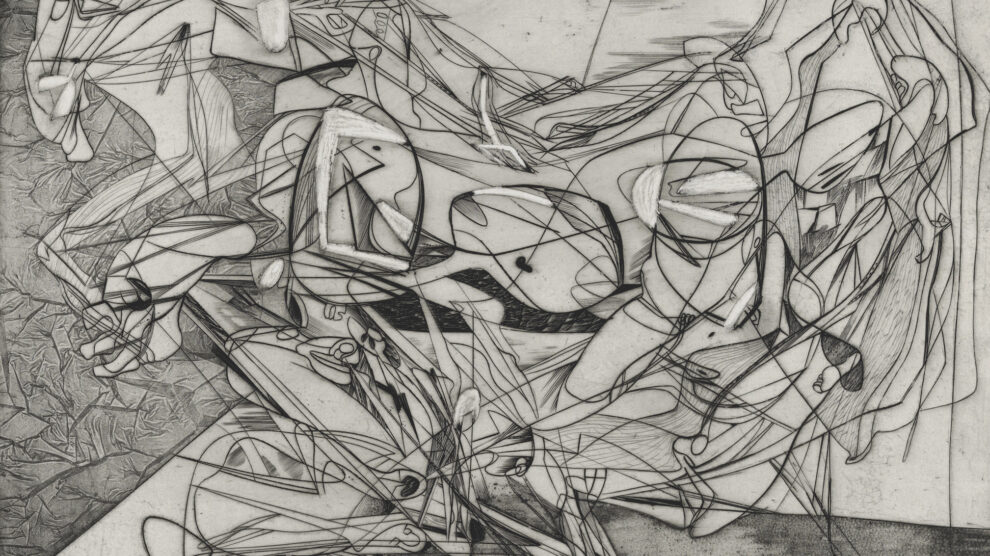
Science and Imperialism: Scientists as Workers for Peace
By Archishman Raju
Volume 25, no. 3, Killing in the Name Of
Imperialism and militarism have always disguised and justified themselves as the defense of freedom. The American President recently called for the unity of the free world, outlining the fight for democracy against autocracy as the defining challenge of our times.1 There is little doubt his fight for “democracy” means the continued funding of the American military apparatus around the world, which will continue to “free” unwilling people who have not yet realized their slavery.
To understand the link between science, imperialism, and militarism, it is important not just to see the complicity of science in militarism at a technological level, but to understand the ideological justification that a narrow view of science provides for the continuation of imperialism and militarism. The foundations of this ideological justification crystallized during the Cold War.
I will argue in this article that two views of science emerged during the Cold War. The first saw science as a technical activity to be pursued by elites who would individually have freedom in deciding their research. The purpose of science and its use in war was thus not a concern for the scientists themselves. The second was explicitly concerned with the moral responsibility of scientists, and had a broader conception of how science could contribute to peace and to the freedom of the masses of people. This second view was particularly important to the anti-colonial struggle, as I will bring out by examining the example of India. It is important today to understand what shaped these two views, as the debate on the proper role of science remains unresolved. This debate takes on added significance in the midst of a rapidly changing world order which is shifting from a unipolar to a multipolar world.
Context of Science before the Cold War
In 1953, a group of scientists from nineteen Western countries gathered in Hamburg in a conference titled Science and Freedom to discuss, as the New York Times reported, “the problem of how [to] defend freedom of science against the encroachments and requirements of the modern state.”2 The conference was sponsored by the Rockefeller Foundation and the Central Intelligence Agency (CIA).3 The central plank of Cold War propaganda was to portray science as objective, disinterested activity that was to be free from political, ideological, and philosophical influence. The task of scientists was the collection and interpretation of facts in a pursuit of truth that was unperturbed by the society they functioned in. It was to put forth the idea of the “free” individual scientist unconcerned with morality and purpose. This was a sophisticated way to put science in the service of the empire by covering it in the facade of objectivity while promoting a subjective and individual definition of freedom.
This Cold War view of science was obviously not novel and had earlier precedent. What made it important was the context in which it was promoted. At the philosophical level, the discovery of quantum mechanics had raised a host of interesting philosophical questions. Bohr, Einstein, and Heisenberg debated the philosophical consequences of the new discoveries, revisiting the question of the objective nature of reality famously debated by Lenin and Bogdanov.4 Bogdanov was following the philosophy of Ernst Mach, an important thinker for the philosophy of logical positivism, who argued that the proper object of scientific study is “sensations” and any discussion of objective reality independent of these sensations is metaphysical. Lenin, in his Materialism and Empirio-criticism, argued that there is an objective reality independent of our sensations and that we can know it.5 Soviet scientists like Vladimir Fock argued that the dominant interpretation of quantum mechanics popularized by Bohr (the Copenhagen interpretation) was just a reiteration of positivism and presented a philosophical defense of dialectical materialism against subjectivism in the face of the new discoveries.6 In both physics and mathematics, the Soviets not only produced an extraordinary set of scientists but also a philosophical interpretation of the results of the field. Similarly, in biology, Soviet science had a big influence—particularly on a group of prominent British biologists who formed the Theoretical Biology Club and were developing an organicist philosophy closely related to dialectical materialism.7
The Western ruling class essentially conducted a campaign of psychological warfare on the dangers of mixing philosophy, politics, and ideology with science.
The revolution in Russia had a huge influence on scientists around the world. In the colonized countries, which started getting political independence soon after the end of the Second World War, Russia served as an example of how rapid scientific and technological development could take place. In countries which had been immiserated and de-industrialized, the Soviet Union assisted in this necessary task of scientific development. In India, for example, the Soviet Union provided technical and scientific assistance, including in setting up the Bhilai steel plant, the Indian Institute of Technology Bombay, and other institutions.8 By 1960, India and the Soviet Union had signed an agreement stating the “desire to maintain and strengthen co-operation in the fields of education, arts, science and technology.”9
Furthermore, scientists and intellectuals had flocked to the defense of peace after seeing the horrors of the Second World War and the rise of fascism. Many scientists admired the role of the Soviet Union in defeating fascism and calling for planned scientific development. Peace congresses were held in Poland, New York, and Paris, which brought together prominent artists and scientists from around the world. In sum, the pre–Cold War period was a time of the churning of ideas, the working out of the consequences of new scientific discoveries for epistemology, and the realization that scientists must play a role that went beyond their laboratory.
The Cold War View of Science
It is in this context that we must understand the Cold War view of science that was promoted by the Western establishment, particularly because it is this view that has become the dominant view of science today. The Western ruling class essentially conducted a campaign of psychological warfare on the dangers of mixing philosophy, politics, and ideology with science. They did this by making an example out of Trofim Lysenko. Lysenko was an agronomist who believed in the inheritance of environmentally acquired characteristics, and whose story has been told elsewhere.10 His legacy today is advertised as the scientist who “probably killed more human beings than any individual scientist in history.”11 These absurd claims were spread during the Cold War period and continue to be propagated.12 Mistakes in Lysenko’s scientific work were not treated in the West as they are in the normal course of science, to be corrected and learnt from; instead they were to serve as a permanent example to the world on the deficiencies of science in a socialist system and, ironically, the danger of mixing science with ideology. The primary meaning of Lysenko’s work became political.
The Western hero who denounced Lysenko was Nobel laureate H. J. Muller, a man who had earlier been influenced by radical ideas but then turned into a fierce anti-communist. Muller had been trained in Thomas Hunt Morgan’s lab, which was foundational to genetics, and thus himself was a geneticist who promoted the fruit fly as a model organism. Muller was also a committed believer in eugenics. In earlier times, Muller had tried to persuade Stalin to take up the project of eugenics: “Many a mother of tomorrow, freed of the fetters of religious superstitions, will be proud to mingle her germ plasm with that of a Lenin or a Darwin, and to contribute to society a child partaking of his biological attributes.” Stalin was not pleased with this idea.13 After getting disillusioned with the Soviet Union, Muller became a key component of the CIA’s propaganda campaign.14
It should be remembered that prior to the fall of fascism, mainstream genetics had closely been linked to eugenics and racism, with eugenics societies flourishing in the Western world. The idea that innate characteristics were most important was an important justification offered for racism. In the United States, the Rockefeller Foundation was involved in the creation of a new science of man, with ideas that were sometimes implicit but nevertheless closely related to eugenics and social control.15 On being questioned about the persecution of geneticists, an article published in the Soviet newspaper Izvestia responded: “There really does not exist in the USSR that ‘freedom’ of genetical science which in certain states is understood as freedom to kill people or as freedom to destroy whole nations because of their alleged ‘inferiority.’”16
Scientific freedom was made consistent with an imperialist system, for the definition of freedom was confined to the freedom of the individual scientist to do their research while being funded by business and war.
Muller had been a key part of the organization of the Hamburg conference in 1953. In an address to the Congress for Cultural Freedom in 1950, he explicitly defended Western civilization as containing values that permitted science and scientific discovery.17 These values were to be defended against totalitarianism. This was just one example of the kind of diatribe that Muller would issue against the Soviet Union. Hence, freedom had found its heroes: the CIA, Rockefeller Foundation, and a eugenicist had come together to protect the free world against the dangers of totalitarianism. What is astonishing in retrospect is how many western scientists, with a few notable exceptions, capitulated to these ideas in the Cold War era.18 The end result was that scientists were told, so to speak, to “shut up and calculate,” be confined to their laboratories, and avoid any association with philosophy or radical ideas. While funding for science greatly increased in this time, most scientists were conveniently content with some limited freedom in their own work. Lobbying for increased funding for science became a value in itself without regard to the purpose of scientific activity.
This was part of a politics that valorized the narrow definition of scientific freedom as a value of the West worth defending. Hence, scientific freedom was made consistent with an imperialist system, for the definition of freedom was confined to the freedom of the individual scientist to do their research while being funded by business and war.19 Furthermore, this idea of scientific freedom could be propagated around the world as a Western value.
The World Federation of Scientific Workers
It is important to remember the alternative vision of science and freedom being developed at the same time, which the Western ruling class was contesting. Many scientists were convinced of the political nature of scientific work after the Second World War. The World Federation of Scientific Workers (WFSW) was officially formed in London in 1946, basing itself on the previous Association of Scientific Workers in Britain. The Federation was primarily formed through the efforts of J.D. Bernal, and the French physicist Frederic Joliot-Curie was appointed the first president. Bernal was a famous crystallographer who by then had written his seminal The Social Function of Science. Frederic Joliot-Curie and Irene Joliot-Curie had jointly received the Nobel Prize for their work in radioactivity. Frederic Joliot-Curie was also the president of the World Peace Council, a movement that strongly supported denuclearization and the cause of oppressed people around the world. At the very outset, the WFSW involved participation from China and India.
Bernal and Curie both theorized that the primary role of scientific workers was in the fight for peace. Thus, the first point in the charter of the World Federation, which was announced a couple of years later in Prague, was “to work for the fullest utilization of science in promoting peace and the welfare of mankind.”20
Joliot-Curie was a strong believer in a genuine scientific internationalism, in the association of scientists with trade unions, and the necessity for scientists to pick sides on great issues of the day. In his words, “Scientists and technicians do not and cannot belong to an elite which is detached from practical contingencies. As citizen members of the great community of workers, they must necessarily be concerned with the use society makes of their discoveries and inventions.”21 Very little historical work has been done on organizations like WFSW and the World Peace Council; academic histories tend to dismiss them as “Soviet-Fronts.” It is thus particularly interesting to see the influence of the WFSW in India, a country that was just emerging into freedom.
The Indian delegate to the foundational conference of WFSW was Meghnad Saha, a prominent physicist elected to represent India. That same year, the journal Science and Culture, which Saha edited, put forth “A Plea for an Association of Scientific Workers,” starting with the lines: “Science can no longer be maintained as a profession of few elites in academic world engaged in leisurely pursuits far away from humdrum of the realities of life.”22 The next page carried an article by Bernal arguing that the two greatest and most immediate problems facing the world are hunger and war, and scientific workers have a role to play in both.
Saha consequently worked to expand the association, and it was formally inaugurated the following year in 1947. Remarkably, the first president of the Association of Scientific Workers of India was also the first prime minister of the country, Jawaharlal Nehru. Nehru believed in the “spirit of science,” which meant to “accept the disintegration of the old” and “not to be tied down to a social fabric or an industrial fabric or even an economic fabric simply because you have carried on with it.”23 He did not think of science as limited to the practice of scientists but as a means of knowledge that had broader application to society. In the Indian Science Congress held in Delhi in 1947, he argued against an abstract idea of scientific truth separated from the lives of people: “For a hungry man or a hungry woman, truth has little meaning. He wants food . . . So science must think in terms of the 400 million persons in India. Obviously, you can only think in these terms and work along these lines on the wider scale of coordinated planning.”24 He was fully committed to scientific planning as the only approach to the problems of a colonized country like India. Despite some internal debate, the Association of Scientific Workers in India supported the activities of the Planning Commission. Opining on the challenges facing India, the Association argued that “the solution of the problem lies in the industrialisation of the country on the basis of a socialist economy.”25 They established a journal, Vijnan-Karmee, for discussing and developing the importance of science from the perspective of the formerly colonized world.26
In a speech to Indian scientists in 1963, Nehru had said, “Naturally, our interest is in India and in the people of India, so that they might get rid of their poverty and other forms of unhappiness. But apart from that, we are convinced searchers after peace—workers for peace.”27 Nehru’s vision for peace was shaped in the struggle against imperialism and included the Inter-Asian Relations Conference of 1947 as well as the historic Bandung Conference of 1955. His idea of peace was a positive idea of peace: “Peace in our view is not merely abstention from war but an active and positive approach to international relations leading to . . . a growing co-operation between nations in various ways.”28
Nehru, in his speeches to scientific workers, would actively encourage them to support the cause of peace and ask them to go beyond their scientific work to consider their responsibility to society. Many prominent scientists in India played a hugely important role in the world peace movement, including figures like D. D. Kosambi and S. S. Sokhey.29
Nehru’s idea of freedom was shaped by the Indian freedom struggle and went beyond bourgeois individual freedom. This idea of freedom actively asked the scientist to take on the responsibility of changing society. Foremost in the scientists’ responsibility was the fight for peace, which set the pre-condition for any other change in society. In a formerly colonized society like India, this was inextricably linked to the fight against hunger and poverty.
Conclusion: Science for Peace
Two visions of science were presented during the Cold War. The Western offensive presented an elite, technocratic view of science which stands above the people. The scientist has a certain narrow freedom in research but is bound to larger processes that are ultimately controlled by foundations and war industries—a framework they are not free to change.
The second is of a scientist with moral responsibility and a philosophical basis to their ideas. This is the legacy of the scientists who participated in the peace movement and the anti-colonial struggles. The formation of the World Federation of Scientific Workers and its branches around the world constituted a moment of great ideological clarity on the purpose of science.
Today, we live in a world that is again divided into camps. The actions of the Western ruling elite have brought the world onto the brink of a nuclear war, and it will become essential for scientists to choose sides and no longer pretend to be neutral. It is no surprise that the general crisis of legitimacy in the West is combined with a loss of trust in science. Scientists are increasingly viewed by the people as allied to the ruling class, as technicians who do the dirty work of the ruling class. To continue to do “science” in a narrow way is unsustainable. It is necessary to revisit these questions on the purpose of science and its relationship to philosophy and the politics that shaped the twentieth century. It is necessary to broaden the objectives of science and to search for a way to root it in the masses of people. It is also necessary for scientists to rededicate themselves to the movement for peace. It is in this process that science can liberate itself from the narrow confines of imperialism and truly realize its relationship with freedom.
—
Archishman Raju currently works at the National Center for Biological Sciences in India. He is associated with the Saturday Free School in Philadelphia, Gandhi Global Family and Intercivilizational Dialogue Project. He is currently part of organizing a series of events to celebrate 75 years of Independence in India and dialogues between India and China for peace.

Notes
- President Joe Biden, The 2022 State of the Union Address, March 1, 2022, https://www.whitehouse.gov/briefing-room/speeches-remarks/2022/03/01/remarks-of-president-joe-biden-state-of-the-union-address-as-delivered/.
- M. S. Handler, “Scientists Demand Greater Freedom,” New York Times, July 25, 1953.
- Audra J. Wolfe, Freedom’s Laboratory: The Cold War Struggle for the Soul of Science (Baltimore: JHU Press, 2018).
- Though I don’t endorse the author’s conclusions, the link between the two debates was recently mentioned in Carlo Rovelli, Helgoland: Making Sense of the Quantum Revolution (New York: Penguin, 2022), 107–112.
- V. I. Lenin, Materialism and Emperio-Criticism, Marxists Internet Archive, https://www.marxists.org/archive/lenin/works/1908/mec/.
- Vladimir A. Fock, “On the Interpretation of Quantum Mechanics” in V. A. Fock—Selected Works: Quantum Mechanics and Quantum Field Theory, ed. L. D. Faddeev, L. A. Khalfin, and I. V. Komarov (Boca Raton, FL: CRC Press, 2004), 539–56.
- Erik L. Peterson, The Life Organic: The Theoretical Biology Club and the Roots of Epigenetics (Pittsburgh, PA: University of Pittsburgh Press, 2017).
- India after independence was committed to a socialistic pattern of society with the state taking control over the commanding heights of the economy including heavy industries.
- Ministry of External Affairs of India, Agreement Regarding Cultural, Scientific and Technical Cooperation (New Delhi: February 12, 1960), MEA Media Center, https://mea.gov.in/bilateral-documents.htm?dtl/6345/Agreement+regarding+Cultural+Scientific+and+Technical+Cooperation.
- See Richard Lewontin and Richard Levins, “The Problem of Lysenkoism,” in The Radicalisation of Science, ed. Hilary Rose and Steven Rose (London: Palgrave, 1976), 32–64.
- Sam Mead, “The Soviet Era’s Deadliest Scientist Is Regaining Popularity in Russia,” The Atlantic, December 20, 2017,https://www.theatlantic.com/science/archive/2017/12/trofim-lysenko-soviet-union-russia/548786/.
- The fact that these claims are absurd is a view supported by even mainstream historians of science. See Wolfe, Freedom’s Laboratory. Also of interest is the comment by Wang, Zhengrong, and Yongsheng Liu, “Lysenko and Russian Genetics: An Alternative View,” European Journal of Human Genetics 25, no. 10 (2017): 1097–8.
- John Glad, “Hermann J. Muller’s 1936 Letter to Stalin,” The Mankind Quarterly 43, no.3 (Spring 2003): 305–319
- Wolfe, Freedom’s Laboratory.
- Lily E. Kay, The Molecular Vision of Life: Caltech, the Rockefeller Foundation, and the Rise of the New Biology (Oxford: Oxford University Press, 1992).
- Greta Jones, Science, Politics and the Cold War (London: Routledge, 1988), 3.
- H. J. Muller, “Science in Bondage” Science 113, no. 2924 (1951): 25–29.
- The exceptions include J.D. Bernal, Frederic Joliot-Curie (mentioned later), JBS Haldane, and also Linus Pauling and Eric Burhop; but the general trend was to disavow any association with radical ideas. See Jessica Wang, American Science in an Age of Anxiety (Chapel Hill, NC:University of North Carolina Press, 1999).
- The relationship between science and freedom was particularly examined by D. D. Kosambi, “Imperialism and Peace, Science and Freedom,” Monthly Review 4 (1952): 200–205, from which this is paraphrased.
- Patrick Petitjean, “The Joint Establishment of the World Federation of Scientific Workers and of UNESCO after World War II,” Minerva 46, no. 2 (2008): 247–70.
- Pierre Biquard, Frederic Joliot-Curie (New York: Paul S. Eriksson, 1966), 99.
- Science and Culture XII, no. 4 (October 1946): 155.
- Jawaharlal Nehru, “The Spirit of Science” in Jawaharlal Nehru on Science & Society, ed. Baldev Singh (New Delhi: Nehru Memorial Museum and Library, 1988), 77.
- “Science in the Service of the Nation,” Science and Culture 12, no. 9 (October 1946): 456.
- “More about the Planning Commission,” Vijnan-Karmee 2, no. 6 (June, 1950): 1.
- Om Prasad, “Vijnan Karmee: Journal of the Association of Scientific Workers of India,” Revolutionary Papers (website), https://revolutionarypapers.org/journal/vijnan-karmee-journal-of-the-association-of-scientific-workers-of-india/.
- Nehru, “Scientific Cooperation,” 261.
- Jawaharlal Nehru, “Speech at Moscow Dynamo Stadium” in Indo-Soviet Relations 1947–1972, ed. Bimal Prasad (Mumbai: Allied Publishers, 1973), 101.
- Prabir Purkayastha, “The Untold Story of the Left in Indian Science,” Newsclick, October 17, 2020, https://www.newsclick.in/The-Untold-Story-Left-Indian-Science. See also Archishman Raju, “The Peace Movement in India: An Important Legacy,” Organization for Positive Peace (website), https://forpositivepeace.org/2019/08/07/the-peace-movement-in-india-an-important-legacy/.





